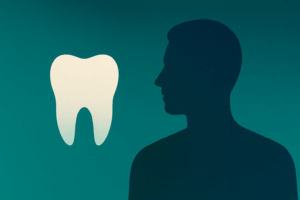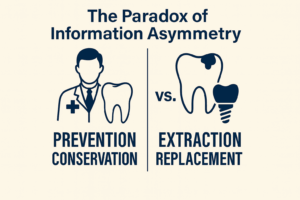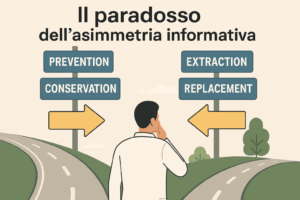When knowledge doesn’t pay: information asymmetry in dentistry
Why those who know more often earn less (and how to avoid it)
Steven Levitt, in Freakonomics, explains how real estate agents exploit information asymmetry: knowing a certain “field” better than their clients. They know the market, the timing, and the dynamics of selling. The homeowner doesn’t. For an agent, it makes no sense to fight for weeks to get €10,000 more: their commission would barely change. Better to close quickly, and close more sales, even if it’s not in the client’s best interest. It’s the power of knowledge used for personal advantage.
The same happens in many industries. An insurance broker, for example, has access to statistical data that allows them to know far better than the customer whether a policy is truly risky or profitable.
In dentistry, however, a unique paradox emerges. The more knowledge and scientific training you have, the more likely you are to recommend conservative treatments: reconstructions instead of extractions, maintenance instead of demolition, prevention instead of surgery. Treatments that are less flashy and, often, less profitable. On the other hand, those who know less – or who twist knowledge into commercial logic – tend to propose more invasive, expensive, and easier-to-sell solutions.
The result is a reversal: knowledge does not maximize profit, but rather ethical responsibility. The dentist who preserves tissue and avoids overtreatment earns less. Patients, lacking critical tools, believe that complexity and cost equal quality, when in fact true expertise lies in subtraction.
Here lies the real issue: maximizing only the technical side eventually becomes self-destructive. The dentist who studies only clinical science risks appearing mediocre in the patient’s eyes, precisely while expressing the highest refinement.
The way out is not to stop studying science, but to combine it with communication and sales skills. Not in a vulgar sense, but as the ability to convey the value of conservative choices, to educate the patient to understand why a simple plan is, in reality, more complex and more valuable.
And this is difficult for those who have studied deeply. As art critic Robert Hughes reminds us:
“The greater the artist, the greater the doubt; perfect confidence is granted to the less talented as a consolation prize.”
Learning to live with clinical doubt while being confident in communication and sales is painful. But if we fail to explain this value, the market will continue to reward those who sell dreams, not those who protect real health. The real challenge of modern dentistry is therefore to integrate science and communication: only then will competence stop being an economic and personal boomerang.
There is another critical point: the strength to redesign our environment to make these choices rewarding. As Steven Levitt notes in the introduction to Freakonomics, the book’s guiding thread is rethinking, in an original way, why people act as they do. If morality draws the world as it should be, economics describes the world as it really is.
Understanding why people make certain choices allows us to see the world around us differently. We may become more skeptical of “conventional wisdom,” we may ask less obvious questions, and we may use our intelligence to develop new ideas.
In the microcosm of the dental office, there are countless choices to be made to make the reality we believe in truly rewarding. I see many colleagues, for instance, charging less for partial adhesive restorations than for full crowns… charging pediatric dentistry a fraction of adult restorative fees… charging less for the complex recovery of a tooth than for an implant.
When the surrounding reality pushes us against our own intentions, we work under maximum strain. The willpower required becomes superhuman. As James Clear, author of Atomic Habits, writes:
“You do not rise to the level of your goals, you fall to the level of your systems.”
Willpower is volatile: if your plan relies only on it, you will fail. Some days, yes, you’re a lion; but on others you’re not… and you give in. Gradually redesigning the environment around us is what makes our project sustainable.
The Japanese, in shaping the concept of ikigai (the idea of happiness), emphasized not only competence and passion for one’s work, but also its social necessity and its fair economic reward. In that framework, those who worked without adequate remuneration were described in just one way: missionaries.
We are not just dentists; we are human beings. And as such we must consider ourselves and our patients. Success in dentistry is much more than a perfectly closed flap, a flawless contact point, a faithfully reproduced anatomy, or a root canal carried to the apex.
Medicine may be a rational and statistical science; but being a doctor is not. Being a doctor also means having the social skills to manage expectations, anxiety, and pain.
As an old saying goes:
“The art of healing comes from nature, not from the physician. Therefore the physician must start from nature, with an open mind.”
The doctor administers himself first.
And this explains why technical competence alone, however high, inevitably leads in one direction: frustration.
Science without communication breeds frustration.
Communication without science breeds illusion.
True dentistry lives only at the meeting point between the two.
🚀 Join me at the Injectable Restorations European Summit!
📍 Milan, November 7–8, 2025
I’ll be giving a lecture titled:
“The Power of Incentives – The hidden forces shaping modern dentistry.”
We’ll explore why the best science often leads to more conservative (and less profitable) treatments,
how incentives distort our daily practice, and what we can do to redesign the system.
👉 Secure your seat now at www.injectionsummit.eu








